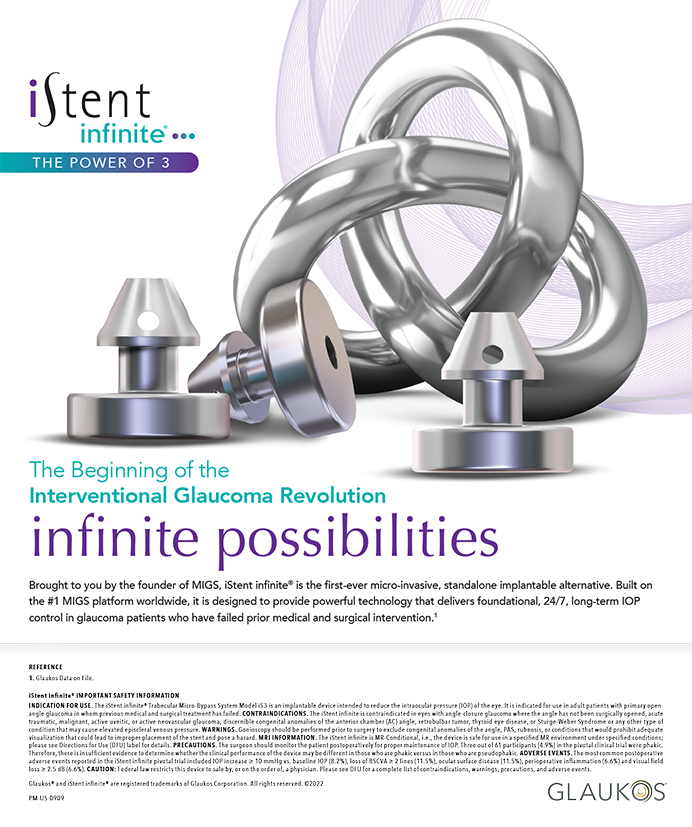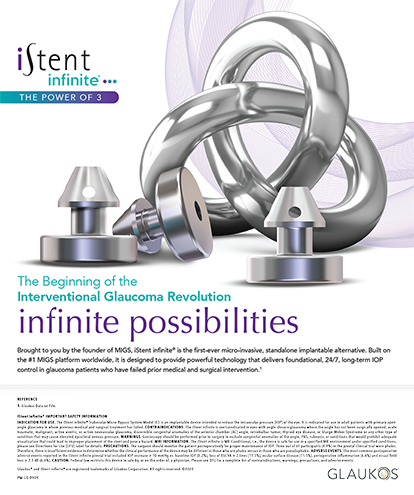
Most cases of elevated IOP after cataract surgery are either self-limiting or easily managed. The cases that require scrupulous workup and aggressive treatment are, fortunately, few and far between. When serious IOP-related complications do occur, however, they should be managed aggressively to avoid potentially sight-threatening complications.
risk factors
Managing postoperative IOP spikes begins during the preoperative evaluation. As is the case with most complications, prevention is the best strategy. Proactively identifying patients at risk for IOP-related issues is key. Meticulous surgery coupled with vigilant follow-up throughout the perioperative period will minimize the risk.
Patients most at risk for IOP issues postoperatively are, naturally, those with existing ocular hypertension or glaucoma. Another risk factor for IOP spikes after cataract surgery is high myopia.1
The potential for IOP spikes is also elevated after complicated procedures, particularly if a secondary surgery such as vitrectomy is required. This can be due to extensive use of an ophthalmic viscosurgical device (OVD), which can be retained in the angle. Extra surgical maneuvers and time in the eye increase the potential for inflammation that can affect aqueous pathways leading to increased IOP.
Intuitively, one might expect patients with narrow angles preoperatively to be at risk for IOP issues. In my practice, I watch these patients closely, but I rarely see IOP spikes after surgery. This is likely due to the lens’ removal opening the angle thus mitigating this risk factor. Similarly, cases performed by residents would seem to be at higher risk than those performed by attending surgeons; however, studies in the literature are divided on whether there is a correlation between resident surgeries and IOP elevation.2,3
INTRAOPERATIVE MEASURES
The best protection against IOP spikes may be meticulous surgery. Extra care should be taken in high-risk eyes to completely remove all OVD, especially in patients with known glaucoma. This step may require extra time in the irrigation/aspiration phase. If a femtosecond laser is available to perform nucleus fragmentation, this should presumably lessen the need for OVD use and therefore lower the chances of inducing inflammation with ultrasound. Dick et al have described a technique for complete avoidance of OVD use during laser cataract surgery.4 This approach likely needs additional investigation before wider adoption.
The type of OVD used during cataract surgery can influence the potential for the material to be retained. Some studies suggest that cohesive OVDs may have a greater potential to become stuck in the trabecular meshwork due to their higher molecular weight.5 However, there are also studies showing no difference in cohesive and dispersive OVDs in terms of postoperative IOP spikes.5
When extracapsular cataract surgery was more widely performed, it was not uncommon for surgeons to use a topical agent such as timolol prophylactically to reduce the potential for postoperative IOP elevation. Some surgeons still do this, although it has largely fallen out of favor with modern cataract surgery techniques and technologies.
POSTOPERATIVE MEASURES
In my practice, I try to examine high risk patients 3 to 5 hours after surgery to get a sense of the early healing period. It is not uncommon to see slightly elevated IOPs during the same day, even in uncomplicated cases,. These mild elevations into the mid-20 mm Hg range typically normalize by the next day. I know that many physicians do not routinely check the IOP on the day of surgery, but I find it helps me to understand the overall pattern of IOP—its peaks and troughs—throughout the postoperative course.
In settings where coordinated care is practiced, it is not uncommon for an eye care professional other than the surgeon to monitor follow-up care. For patients being managed under shared care who fall into one of the categories mentioned, it may be desirable for the surgeon to be closely involved in the early postoperative period in case an additional procedure is required. At the very least, the other members of these patients’ eye care team should be alerted to the potential risk of IOP elevation so that extra vigilance can be undertaken.
What exactly constitutes an elevated IOP is debatable. One school of thought counts IOPs greater than 28 mm Hg as elevated and warranting intervention. I prefer to look at patients individually to determine whether intervention is required. For instance, I would be more aggressive in a patient with glaucoma, whereas a younger patient with no known history of IOP issues and a healthy optic nerve may be able to be monitored before treatment is initiated. I usually use a cutoff of 28 mm Hg in asymptomatic patients with no known glaucoma as a threshold for instituting topical therapy; higher IOPs or symptomatic cases require more aggressive approaches.
When I use a drop to lower IOP on postoperative day 1, I like to see if there is a response in the first couple of hours. I find that patients who respond well to the initial topical drop do very well. Their course is generally benign, and I leave them on the topical agent for 3 days. If there is minimal response, I know there is a need for more careful follow-up and treatment. This may include instituting oral agents, such as acetazolamide, or performing anterior chamber paracentesis.
For glaucoma patients, I make sure that they know to continue their glaucoma medications throughout the postoperative period.
ELEVATING CARE
Because the occurrence is so common, managing IOP spikes after cataract surgery should be within the purview of most if not all anterior segment surgeons. Especially for high-volume surgeons, IOP spikes are inevitable. I would certainly feel comfortable referring to a glaucoma specialist should the case warrant such care; however, in all my years of practice, I have yet to need to do that.
When IOP spikes occur in the context of collaborative care, it pays to have established relationships with your network. If such an event occurs, the referring optometrist or the person following the case postoperatively should feel absolute comfort contacting the surgeon to discuss the case. I make it a practice to communicate with the partner doctor who manages the cases with me on the day after surgery. I have found it valuable to be personally involved in the care of patients and to serve as a resource for those in my referral network whenever needed.
1. Fan F, Luo Y, Lu Y, Liu X. Reasons for early ocular hypertension after uneventful cataract surgery. Eur J Ophthalmol. 2014;24(5):712-717.
2. Elfersy AJ, Prinzi RA, Peracha ZH, et al. IOP elevation after cataract surgery: results for residents and senior staff at Henry Ford Health System [published online ahead of print March 29, 2016]. J Glaucoma.
3. Kim JY, Jo MW, Brauner SC, ET AL. Increased intraocular pressure on the first postoperative day following resident-performed cataract surgery. Eye (Lond). 2011;25(7):929-936.
4. Dick HB, Gerste RD, Rivera RP, Schultz T. Femtosecond laser-assisted cataract surgery without ophthalmic viscosurgical devices. J Refract Surg. 2013;29(11):784-787.
5. Young M. OVD selection. EyeWorld. Ocotber 2007. http://www.eyeworld.org/article.php?sid=4035
Michael Summerfield, MD
• founder, Washington Eye Institute, Washington, District of Columbia and residency program director, Georgetown University and Washington Hospital Center
• michaelsummerfield@gmail.com
• financial interest: none acknowledged


